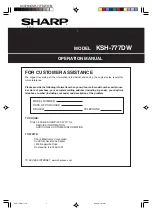
This is used for slow cooking, keeping food warm and warming plates for short
periods. Extra care must be taken when warming bone china as it may be damaged it
if gets too hot.
Some advantages of slow cooking are:
The oven stays cleaner because there is less splashing.
Timing of food is not as critical, so there is less fear of overcooking.
Inexpensive cuts of meat are tenderised.
It is important to follow the guidelines given for preparing food using the ‘Slow’
setting.
USING THE ‘SLOW’ SETTING
1.
All dishes cooked by the ‘Slow’ setting should be cooked for a minimum of 6
hours. They will ‘hold’ at this setting for a further hour but marked deterioration in
appearance will be noticed in some cases.
2.
Joints of meat and poultry should be cooked at fan oven 170
o
C for 30 minutes
before turning to the ‘Slow’ setting.
3.
Joints of meat over 6 lbs (2.7kg) and poultry over 4 lbs 8oz (2 kg) should not be
cooked using the ‘Slow’ setting.
4.
Always stand covered joints on a rack over the meat tin to allow good air
circulation.
5.
A meat thermometer should be used when cooking pork joints and poultry.
The internal temperature of the food should reach at least 88
o
C.
6.
This method is unsuitable for stuffed meat and stuffed poultry.
7.
Always bring soups, casseroles and liquids to the boil before putting in the oven.
8.
Cover casseroles with foil and then the lid to prevent loss of moisture.
9.
Always thaw frozen food completely before cooking.
10. Root vegetables will cook better if cut into small pieces.
11. Adjust seasonings and thickenings at the end of the cooking time.
12. Egg and fish dishes need only 1-5 hours cooking and should be included in day
cooking sessions, when they can be observed from time to time.
13. Dried red kidney beans must be boiled for a minimum of ten minutes after
soaking, before inclusion in any dish.
STORAGE AND RE-HEATING OF FOOD
It is vitally important to strictly adhere to the basic principles of food handling and
hygiene to prevent the possibility of bacterial growth.
1.
If food is to be frozen or not served immediately, cool it in a clean container as
quickly as possible.
2.
Completely thaw frozen food in the refrigerator before re-heating.
3.
Re-heat food thoroughly and quickly either on the hotplate or in the fan oven at
170
o
C and then serve immediately.
4.
Only re-heat food once.
18
THE ‘SLOW’ SETTING 90
o
C
Summary of Contents for WINCHESTER Mk2
Page 35: ......
















































